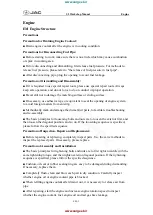
15
A Product of Progress Mfg. Inc.
Measure from the ground
to fender through the
center-line of the axle.
Rear
Front
Figure 18
Weight Distribution Setup Table
FRONT Example
A
Tow vehicle loaded for trip but still uncoupled from trailer
28”
B
Trailer coupled but NO weight distribution
30”
Calculate height halfway between A and B (A+B)÷2=
29”
C
Trailer coupled with weight distribution engaged. Should
be
at least halfway back
to line A. Higher than this
may still be under adjusted. Lower than line A is over
adjusted. See Step 7 - Weight Distribution Adjustments.
28”-29”
Good
__________
29”-30”
Need More
Release the bars by lifting the locking tab and rolling the bar out of the top socket of
the hitch head.
Frequently apply a thin coat of bearing grease to the area of the spring bar knuckles
where they rub inside the hitch head sockets to reduce wear and make insertion
easier. This will also reduce hitch noise.
It is not necessary to apply lubricant to the joint where the spring bars rest on the
L-bracket. This may decrease the amount of sway control provided by the hitch.
Step 6 - Weight Distribution Setup
Before starting the weight distribution setup, turn off or disable the auto-level
system. See Appendix C, p. 28.
Good weight distribution is a critical component of the e2 hitch setup to get the best
performance from your hitch. Every tow vehicle and trailer combination will react
differently to weight distribution.
To correctly set up weight distribution you must take three measurements at the
front of your tow vehicle. See Figure 18. First, measure without the trailer coupled.
Next, measure with the trailer coupled, but with no weight distribution. Third,
measure with the trailer coupled and the spring bars in place.
















































